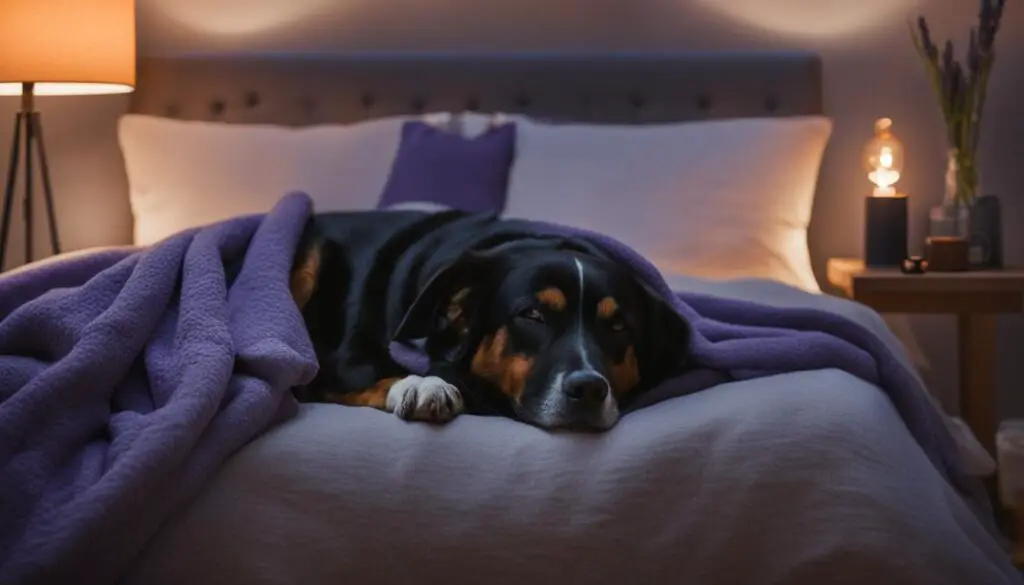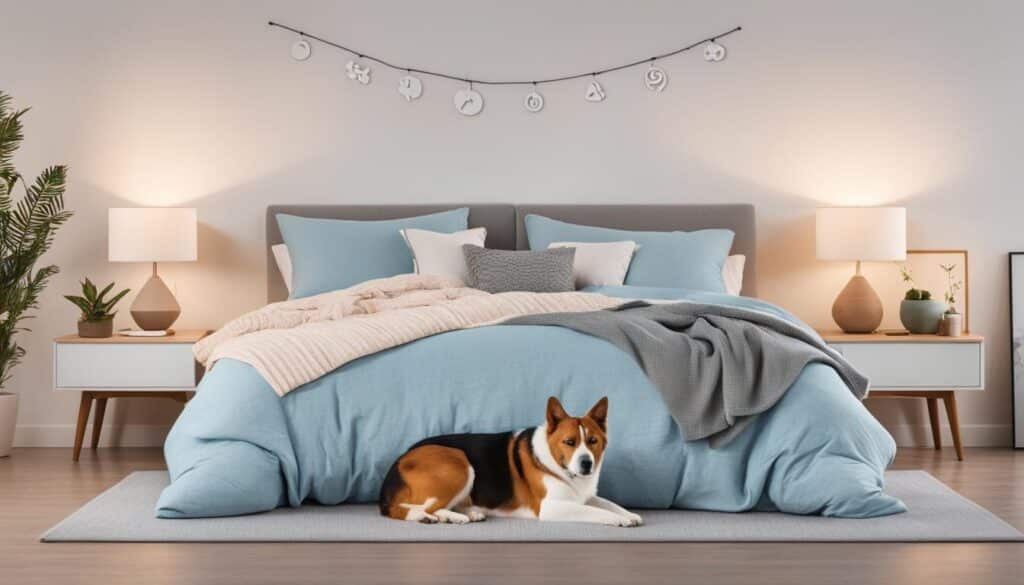Cats and dogs have different sleep-wake cycles, with cats being crepuscular and dogs being diurnal animals. This can create challenges for pet owners when it comes to managing their pet’s nighttime behavior. Nocturnal disturbances by pets can cause sleep disruptions for both the owner and the pet, leading to fatigue and frustration.
Addressing these nocturnal disturbances is essential to ensure a peaceful night’s sleep for everyone involved. By understanding the reasons behind these behaviors and implementing effective strategies, pet owners can manage their pet’s nighttime activities and promote better sleep for both themselves and their furry companions.
Key Takeaways:
- Understanding that cats are crepuscular and dogs are diurnal can help pet owners anticipate nocturnal behaviors.
- Nocturnal disturbances in cats can be caused by factors such as being home alone, boredom, hunger, old age, or health conditions.
- Managing a cat’s nighttime behavior can be done through adjustments like engaging in daytime play, changing the feeding schedule, providing daytime activities, or seeking veterinary advice.
- Dogs can experience anxiety and stress that lead to nighttime disturbances such as excessive barking, whining, destructive behavior, and panting.
- Addressing a dog’s anxiety can be done through strategies like creating a consistent schedule, playing music or white noise, providing exercise and mental stimulation, utilizing pheromones, grooming, and desensitization techniques.
Understanding Cats’ Nocturnal Behavior and Techniques to Address It
Cats are crepuscular animals, naturally inclined to be active during the evening and early morning hours. Their nocturnal behavior can sometimes disrupt the sleep of both cats and their owners. Let’s explore some techniques to address these nighttime disturbances and ensure a restful night for everyone involved.
Tiring Out Your Cat Through Play
One effective way to manage a cat’s nighttime behavior is by engaging in daytime play sessions. Interacting with toys like laser lights, cat teasers, or playing fetch can help tire out your cat and expend their energy. This physical activity during the day can promote better sleep at night.
Adjusting the Feeding Schedule
Changing the feeding schedule can also help make your cat sleepy before bedtime. Instead of providing one large meal in the evening, consider offering smaller, more frequent meals throughout the day. Moving the evening meal to a later time can help mimic natural hunting behaviors and encourage your cat to rest during the night.
Daytime Activities to Keep Your Cat Entertained
Providing daytime activities for your cat can prevent boredom and reduce their nocturnal disturbances. Use feeding toys or puzzle toys to keep them mentally stimulated and engaged during the day. Rotate their toys regularly to keep them interested and consider setting up a cozy sleep area away from your bedroom to provide a quiet and comfortable space for them to rest.
“Engaging in daytime play, adjusting the feeding schedule, and providing daytime activities can help manage a cat’s nocturnal behavior and promote better sleep at night.”
In cases where behavioral adjustments do not effectively address your cat’s nighttime disturbances, it is recommended to seek veterinary consultation. A veterinarian can help rule out any underlying health or medical conditions that may be contributing to your cat’s nocturnal behavior and provide further guidance and solutions.
Understanding your cat’s nocturnal behavior and implementing appropriate techniques can help create a peaceful sleeping environment for both you and your furry friend. By providing engaging daytime activities, adjusting the feeding schedule, and seeking veterinary advice when needed, you can address your cat’s nighttime disturbances and improve sleep quality for everyone.
Managing Dogs’ Anxiety and Promoting Calmness at Night
Dogs, like humans, can experience anxiety and stress that can disrupt their sleep patterns and cause nocturnal disturbances. Some common reasons for dogs’ anxiety include separation anxiety, fear of loud noises, changes in routine or environment. It’s crucial for pet owners to recognize the signs of anxiety in their furry companions, which can include excessive barking, whining, destructive behavior, panting, pacing, trembling, loss of appetite, or trying to hide or escape from stressful situations.
To help calm anxious dogs and promote a sense of calmness at night, there are several strategies that pet owners can employ:
- Establish and maintain a consistent schedule: Dogs thrive on routines, so creating a regular schedule for feeding, exercise, and bedtime can help reduce anxiety and promote a sense of security.
- Provide regular exercise and mental stimulation: Physical activity and mental stimulation help dogs release pent-up energy and reduce anxiety. Engaging in activities like daily walks, interactive play, or puzzle toys can tire out dogs and promote a more relaxed state.
- Play music or white noise: Soft music or white noise can help mask external noises and create a soothing environment for dogs. This can help drown out sudden sounds that may trigger anxiety.
- Consider using Thundershirts: Thundershirts are specially designed garments that provide gentle, constant pressure to help alleviate anxiety in dogs. They work similar to swaddling an infant and can provide a sense of comfort and security.
- Grooming: Regular grooming sessions can have a calming effect on dogs. Brushing their coat, trimming their nails, and giving them a gentle massage can help reduce anxiety and promote relaxation.
- Incorporate desensitization techniques: Gradual exposure to anxiety-inducing situations can help desensitize dogs and reduce their fear or anxiety. This can be done by gradually introducing them to loud noises or unfamiliar environments in a controlled and positive manner.
- Consider natural supplements: Some natural supplements, such as chamomile or lavender, can have a calming effect on dogs. However, it’s important to consult with a veterinarian before introducing any supplements to ensure they are safe and appropriate for your dog.
Implementing these strategies can help create a soothing environment, reduce stress and anxiety levels, and promote relaxation and a good night’s sleep for dogs. However, it is important to remember that every dog is unique, and what works for one may not work for another. It’s recommended to consult with a veterinarian to develop an individualized plan based on your dog’s specific needs and to rule out any underlying medical causes for their anxiety.
Strategies to Improve Sleep for Pet Owners
Pet owners often find themselves grappling with disrupted sleep due to their beloved pets’ nocturnal activities. It can be challenging to get a good night’s sleep when our furry friends are causing disturbances during the night. However, there are strategies that pet owners can employ to improve sleep quality for both themselves and their pets.
Addressing Nocturnal Disturbances in Cats
Cats are known for their nocturnal tendencies, which can include behaviors like wild play, attacking, and meowing during the night. To address these disturbances, cat owners can incorporate the following strategies:
- Engage in daytime play sessions to tire out the cat and encourage restful sleep at night.
- Adjust the feeding schedule by providing smaller, more frequent meals during the day and moving the evening meal to a later time, promoting sleepiness before bedtime.
- Provide daytime activities such as interactive toys, scratching posts, and hiding spots to keep the cat entertained and mentally stimulated during the day.
- Create a separate sleep area for the cat away from the bedroom, reducing the chances of nighttime disruptions.
If these adjustments do not alleviate the nocturnal disturbances, it is advisable to seek guidance from a veterinarian to rule out any underlying health conditions or behavioral issues.
Aiding Dogs’ Calmness and Reducing Anxiety at Night
Dogs may experience anxiety and stress, leading to disturbances such as excessive barking, panting, and restlessness during the night. Pet owners can implement the following strategies to promote calmness:
- Create and maintain a consistent schedule for feeding, exercise, and sleep to establish a sense of routine and security for the dog.
- Play soothing music or white noise in the background to drown out external sounds that may trigger anxiety.
- Consider using calming aids like Thundershirts, which provide gentle pressure to help dogs relax.
- Provide regular exercise and mental stimulation throughout the day to tire out the dog and promote restful sleep.
- Utilize pheromone diffusers or sprays to create a calming environment for the dog.
- Grooming the dog before bedtime can be a calming ritual that helps them relax.
- Implement desensitization techniques to gradually expose the dog to the triggers of their anxiety, helping them become more comfortable over time.
To ensure the best approach for addressing anxiety and promoting calmness, pet owners should consult with a veterinarian to develop a personalized plan based on their dog’s specific needs and temperament.
Conclusion
Nocturnal disturbances by pets can greatly impact the sleep quality of both the pet owner and the pet itself. However, there are effective strategies that can be implemented to address these disturbances and promote a peaceful night’s sleep for everyone involved.
For cat owners, managing a cat’s nocturnal behavior can be achieved through various techniques. Engaging in daytime play, adjusting the feeding schedule to encourage sleepiness at night, providing daytime activities, and creating a separate sleep area away from the bedroom can all contribute to reducing nighttime disturbances.
Similarly, for dog owners, addressing anxiety is key to improving sleep quality. Establishing a consistent schedule, playing calming music or white noise, utilizing Thundershirts, providing regular exercise and mental stimulation, and considering natural supplements or desensitization techniques can all help calm anxious dogs and promote better sleep at night for both the owner and the pet.
By taking the appropriate measures and consulting with a veterinarian, pet owners can create a sleep-friendly environment for themselves and their furry companions. It is important to understand the underlying reasons for the disturbances and tailor the strategies to the specific needs of the pet. With patience, consistency, and proper guidance, managing pet’s nighttime behavior and improving sleep quality for pet owners is definitely possible.
FAQ
Can cats be trained to sleep at night?
Yes, cats can be trained to sleep at night. By engaging in daytime play, changing the feeding schedule, providing daytime activities, managing space, and seeking veterinary advice for medications or health issues, cat owners can help promote sleep at night for their feline companions.
What are the common signs of anxiety in dogs?
Common signs of anxiety in dogs include excessive barking, whining, destructive behavior, panting, pacing, trembling, loss of appetite, or trying to hide or escape from stressful situations.
Are there natural remedies to calm anxious dogs at night?
Yes, there are natural remedies to calm anxious dogs at night. Establishing and maintaining a consistent schedule, providing regular exercise and mental stimulation, playing music or white noise, using Thundershirts, grooming, incorporating desensitization techniques, and considering natural supplements are some methods that can help promote relaxation and a good night’s sleep for anxious dogs.
How can pet owners manage their cat’s nocturnal behavior?
Pet owners can manage their cat’s nocturnal behavior by engaging in daytime play with toys, changing the feeding schedule, providing daytime activities, and managing space. These adjustments can help tire out the cat, promote sleep at night, and keep cats entertained during the day.
What can pet owners do to improve sleep quality?
To improve sleep quality, pet owners can take measures such as managing their pet’s nighttime behavior, creating a consistent schedule, playing music or white noise, using Thundershirts, providing exercise and mental stimulation, utilizing pheromones, grooming, and employing desensitization techniques. Consulting with a veterinarian is recommended to develop a personalized plan based on the pet’s specific needs.







No Comments